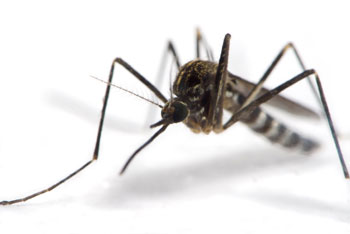Tiny Mosquito
Dangers of the Aedes Mosquito
The Aedes mosquito includes well over 700 species and received its name from Johann Wilhelm Meigen in 1818. In fact, the definition for the Greek word ‘aedes’ means ‘unpleasant’ or ‘odious’, an accurate description for this distinctive insect.
Besides its white eyes, tiny size, black and white stripes, and fascinating appearance, the Aedes mosquito’s bite can be deadly. For its blood meal, it prefers biting humans rather than animals and should therefore be avoided, if at all possible.
What Types of Diseases does the Aedes Mosquito Carry?
 The
diseases that can be transmitted to humans by the Aedes often create serious
health problems, and can be potentially fatal. The most dangerous illnesses
associated with the Aedes are dengue fever and yellow fever, which manifest
a variety of distressing symptoms, the most common being influenza, fever,
jaundice, and muscle and joint pain. The species Aedes polynesiensis is
responsible for human lymphatic filariasis that can result in elephantiasis.
The
diseases that can be transmitted to humans by the Aedes often create serious
health problems, and can be potentially fatal. The most dangerous illnesses
associated with the Aedes are dengue fever and yellow fever, which manifest
a variety of distressing symptoms, the most common being influenza, fever,
jaundice, and muscle and joint pain. The species Aedes polynesiensis is
responsible for human lymphatic filariasis that can result in elephantiasis.
The female Aedes mosquito is fully responsible for spreading disease to humans. In order to provide her eggs with nourishment, it needs to feed on blood. Males do not bite humans; they primarily feed on plant nectar.
The Life Cycle of the Aedes Mosquito
Like many other types of mosquitoes, the Aedes will go through
four stages: egg, larva, pupa, and adulthood. Once the female lays her
eggs in a suitable pool of water, they can hatch and the larvae can emerge
the very same day, given the proper environmental conditions. After approximately
four days, the larvae transform into pupae and remain helpless in the
water for two days, after which time the mosquitoes become full-grown
adults and are able to fly, breed, and feed. The female can breed three
days later. After she has found a blood meal, she will lay her eggs in
water, and the cycle begins all over again. The Aedes mosquito has a lifespan
of about two weeks in nature, although it is possible for it to live longer
given a fitting environment.
Where to Find the Aedes Mosquito
The Aedes mosquito is typically located in tropical countries
and subtropical zones such as the southern United States. However, due
to human activity, some species have been found in temperate areas and
other regions of the planet such as Asia and the Arctic.
In urban areas, it is possible to discover the eggs of the Aedes in various exterior objects where water collects. Garden pots, used tires, children’s pools, roof tanks and rain barrels are ideal spots for a female mosquito to lay her eggs. Therefore, it might be worthwhile to inspect your property and attempt to eliminate items that collect water in order to limit mosquito breeding.
Home - Mosquitoes - Bites - Control - Diseases - Resources - Site Map